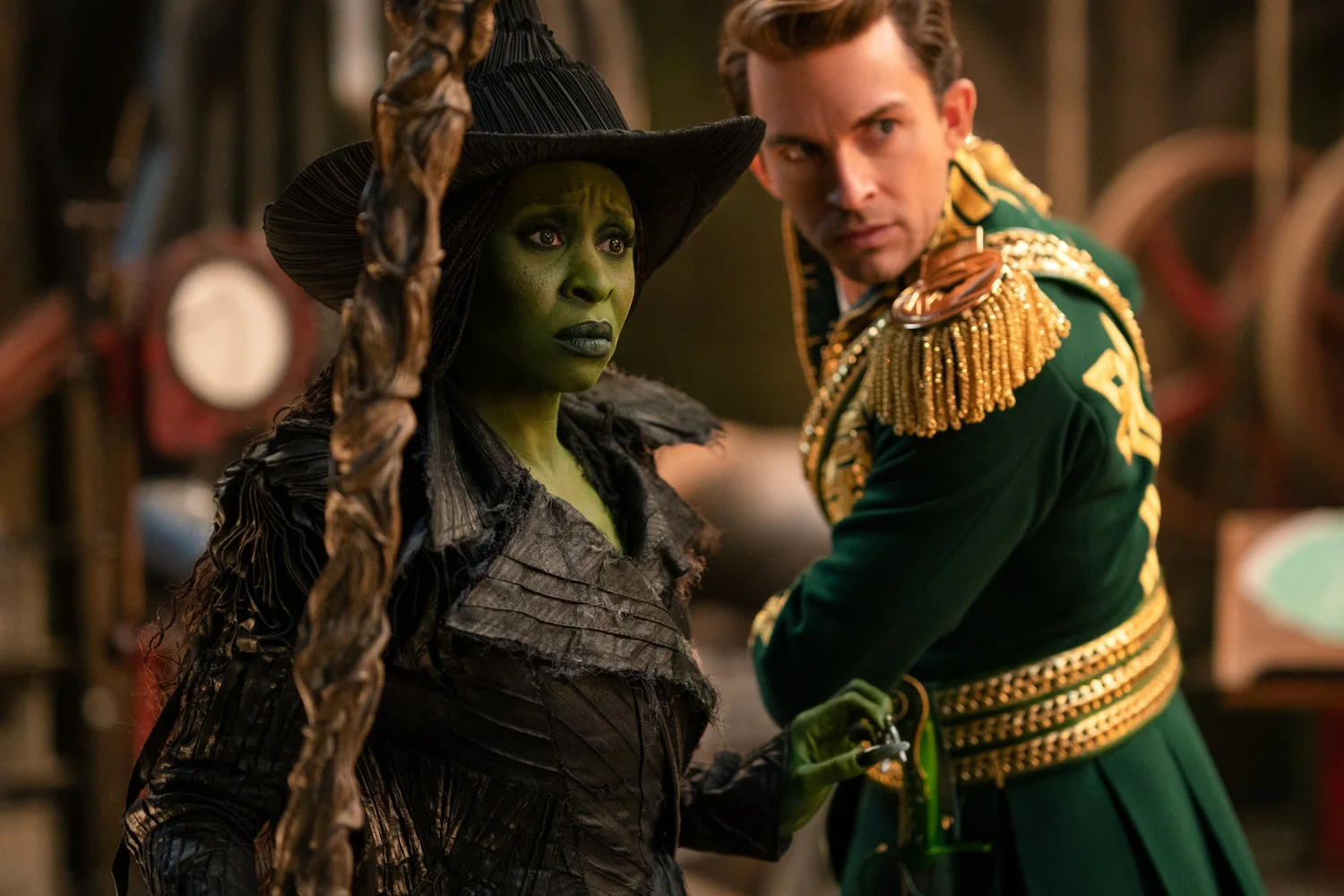Images courtesy of Universal Pictures
WICKED: FOR GOOD— 4 STARS
Matching the changing weather and seasons happening in much of the world during the time of its illustrious release, Wicked: For Good requires more than one firm temperature check, if you will. This bookend finale asks a great deal of its audience with a decidedly different mood, as the plot leaps five years ahead in time from the events of last year’s Wicked. Much of the bright, sunny, and friendly school-aged singing and dancing has evolved to power ballads that emote the traumatic heft of current circumstances. In line with the inherent problem with any sort of prequel, astute viewers and longtime fans know fate is approaching in multiple directions, and it’s more than a little stormy.
In these five years since Elephaba Thropp (three-time Oscar nominee Cynthia Erivo) discovered her untapped magical power, enchanted a broom as her preferred mode of transportation, and donned her rugged onyx-hued garb, the reams and posters of printed propaganda engineered by Madame Morrible (Michelle Yeoh of Everything Everywhere All at Once) and spewing out of the Emerald City have branded her the monstrous “Wicked Witch of the West.” Inserting herself in the affairs of the sham Wizard of Oz (national treasure Jeff Goldblum) as an advocate and disruptor, Elphaba continues to raid and instigate skirmishes in the name of animal rights against the Wizard’s Guard as they near completion of the campaign-promised infrastructure centerpiece: The Yellow Brick Road. After these years of Orwellian sway, Elphaba is losing, as more and more animals—including a certain rescued, quaking lion cub all grown up now—are considering retreating to other realms.
LESSON #1: THE EFFECTIVENESS OF MESSAGE MANIPULATION— In another chapter of cinema’s unwritten rule of “Every Movie Has Politics,” the grand designs of the Wizard and Madam Morrible have steeped and influenced an empty-headed public to the point they will believe anything from his high perch and, worse, desperately want to believe it because of the Wizard’s manufactured aura. Try as she may, Elphaba’s rallying cry of “There’s no place like home!” fails to inspire the tired rabble of defeated fauna. She would love nothing more than to expose the Wizard’s false power, but, at this point, that would take the old carny himself addressing the public with the truth from his own mouth, something that is not going to happen without great pressure or calamity.
Caught in the middle of this feud of fantastical domestic terrorism versus the shiny oligarchy in Wicked: For Good is the private turmoil and love triangle between Elphaba and two old Shiz classmates who have ascended into positions of power. Morrible, continuing as the background puppeteer, massages the ego of the magically barren attention whore, Glinda Upland (fellow Oscar nominee Ariana Grande-Butera), and shapes her into the fake-it-’til-you-make-it witch, Glinda the Good, with the flashy accouterments of a flying bubble vehicle and a lavish “wand” sceptre. She’s set to marry Prince Fiyero Tigelaar (People’s newest “Sexiest Man Alive,” Jonathan Bailey), the Captain of the Wizard’s Guard, though he carries unrequited feelings for Elphaba and her cause.
LESSON #2: PERPETUATING LIES— If Wicked: For Good is starting to sound like a daytime soap opera—a grand one at that—you’re picking up what returning original musical playwright Winnie Holzman and What Happens in Vegas screenwriter Dana Fox are putting down. Lies are happening from all sides, from the little white ones to integrity-shattering wrecking balls. They are being perpetuated for societal, personal, and positional gain, with deep ploys that hope to extend them as long as possible. As a result of these competing parallel paths separated by moral strife, friendships, allegiances, and romances are soured. This is the somber half of the musical, and the central acting matches that accordingly, with both female leads rising to even higher compelling levels of challenged bonding than the first film.
These overflowing deceptions drive much of the cloudy tone looming over Wicked: For Good, and the foreshadowing is extremely heavy. As aforementioned, the trouble with prequels is that we know—all too well—the doom and death coming. At some point, someone’s heart is going to be traded for steel, another person is going to be turned into straw, a house is going to get dropped on someone’s sister, and a beef over bequeathed sparkly shoes will ensue. Newbies will be swept up in the twists, where veteran lovers of the Broadway musical and (less so) the cited 1995 source novel from Gregory Maguire will be ready for every heart-tugging beat and mini-tragedy.
From a performance and blockbuster standpoint, this sequel from In the Heights director Jon M. Chu carries fewer showstopping numbers, even with the addition of two new original songs—”No Place Like Home” for Erivo and “The Girl in the Bubble” for Grande—added to the milieu. Yet, with the youthful origins out of the way, Wicked: For Good gets down to business and becomes a stronger film for it. The plot is thicker and tighter than Wicked, and is thankfully half an hour shorter. That said, Wicked:For Good does not skimp on production value. If anything, the higher stakes increase the grandeur of the greenly gilded deco style provided by Oscar-winning production designer Nathan Crowley as it prepares to have its luster tarnished in a timely and meaningful fashion.
LESSON #3: ACCEPTING REVISIONIST ALTERATIONS— Circling back to the introduction, perhaps the greatest temperature check of all for Wicked: For Good and its predecessor is one’s flexible or inflexible affinity for 1939’s The Wizard of Oz and L. Frank Baum’s core 1900 text. Though it’s an outright classic, Victor Fleming’s fairy tale is damn nearly 90 years old, where there are generations raised more on Wicked than its inspiration, and that’s going to tint things between the competing purists. The entirety of the cherished classic film’s plot occurs in the background during this second film, and somewhat rushed and clunkily weaves into the destinies of Wicked’s intentionally altered and expanded character histories. Wicked’s chief goal has always been shifting sympathies, not unlike the recent outstanding Planet of the Apes reboot prequels, which turned the “damn dirty apes” into the heroes of their story. Those arriving at Wicked: For Good questioning how and when AFI’s #4 villain of all-time will finally manifest from the musical’s clear protagonist will have to make a leap that diehards have accepted since 2003. For some traditionalists, that remains a tough bucket of water to take.
LOGO DESIGNED BY MEENTS ILLUSTRATED (#1352)



